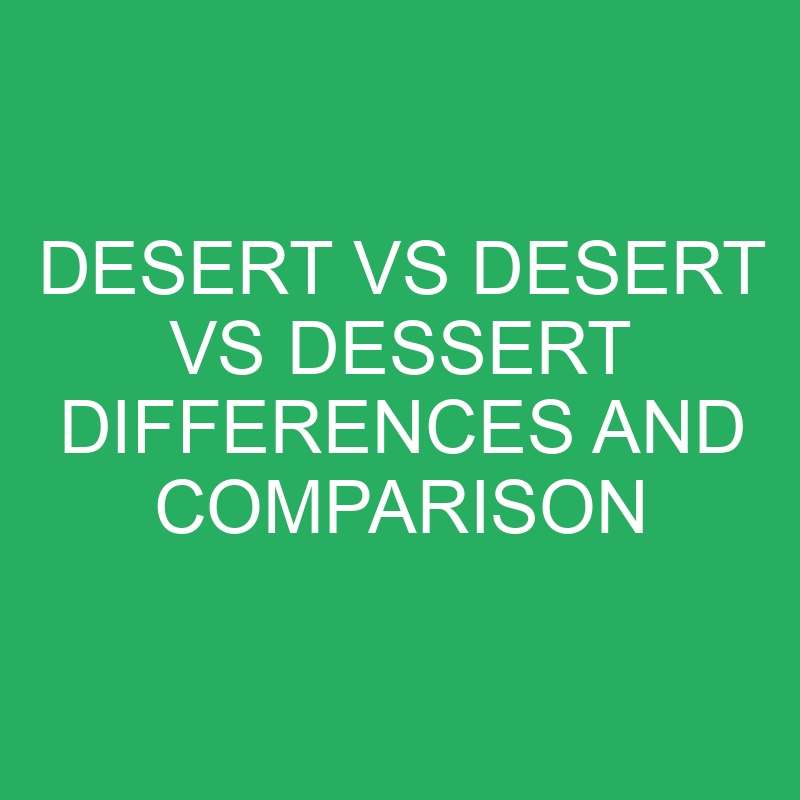Desert” (To Abandon), “Desert” (Dry Land), and “Dessert” (After-Dinner Treat)
The English language, with its fascinating array of homophones, introduces a trio of words that, despite sharing similar pronunciations, embark on different linguistic journeys. “Desert” (to abandon), “desert” (dry land), and “dessert” (after-dinner treat) are homophones that, when not distinguished, can lead to semantic mirages. In this exploration, we will traverse the meanings and applications of each term, navigating the diverse terrains they represent.
Post Contents
Desert – To Abandon:
Definition: As a verb, “desert” means to abandon or forsake, leaving behind without intent to return. It is often used in the context of people or things being deserted due to neglect or a conscious decision to leave.
Desert – To Abandon:
- Example: After years of mistreatment, he decided to desert the toxic workplace for a more positive environment.
- Usage: In this context, “desert” signifies the act of abandoning or leaving behind, often due to unfavorable or harmful conditions.
- Example: The soldier faced severe consequences for attempting to desert his duty during the challenging mission.
- Usage: In a military context, “desert” refers to the unauthorized abandonment of one’s assigned duties or post.
- Example: Despite promising to help, he chose to desert his friend in need, leaving him to face the difficulties alone.
- Usage: Here, “desert” implies the act of abandoning a friend or companion in a time of need or trouble.
- Example: The employee felt compelled to desert the sinking company as financial troubles continued to escalate.
- Usage: In a professional setting, “desert” can indicate leaving a company or organization due to insurmountable challenges.
Desert – Dry Land:
Definition: As a noun, “desert” refers to a barren, arid region with sparse vegetation, typically characterized by a lack of precipitation. It represents landscapes where the ratio of evaporation to rainfall is high.
Desert – Dry Land:
- Example: The Sahara is the largest hot desert in the world, covering vast stretches of Northern Africa.
- Usage: In geography, “desert” refers to a barren, arid landscape with minimal precipitation, characterized by sand dunes and extreme temperatures.
- Example: Many unique plant and animal species have adapted to thrive in the harsh conditions of the desert.
- Usage: Ecologically, “desert” describes an environment with specific flora and fauna adapted to survive in low-water conditions.
- Example: The ancient city was lost in the desert, buried beneath layers of sand over centuries.
- Usage: Archaeologically, “desert” may refer to areas where civilizations existed but were eventually abandoned and covered by desertification.
- Example: Explorers embarked on a challenging journey across the Australian desert, facing extreme heat and limited water sources.
- Usage: In travel and exploration, “desert” denotes vast, dry regions that pose challenges to those navigating through them.
Dessert – After-Dinner Treat:
- Example: For the grand finale, the chef prepared a delectable chocolate mousse as the dessert for the evening.
- Usage: In culinary terms, “dessert” refers to the sweet course typically enjoyed at the end of a meal.
- Example: The restaurant is renowned for its creative desserts, offering a variety of tempting options to satisfy every sweet tooth.
- Usage: When discussing dining experiences, “dessert” denotes the sweet dishes that conclude a meal on a delightful note.
- Example: Family traditions include gathering after dinner to enjoy homemade desserts, fostering a sense of togetherness.
- Usage: Socially, “dessert” becomes a focal point for shared moments, symbolizing indulgence and enjoyment.
- Example: The pastry chef showcased her expertise by crafting an exquisite dessert buffet featuring an array of flavors and textures.
- Usage: Professionally, “dessert” becomes an art form, with chefs creating elaborate and visually appealing sweet treats.
Homophones: The trio of “desert” (to abandon), “desert” (dry land), and “dessert” (after-dinner treat) exemplifies homophones – words that share the same pronunciation but have different meanings. Accurate interpretation relies on context and understanding the specific nuances of each usage.
Common Pitfalls and Clarifications:
- Desert vs. Dessert: Abandonment vs. Treat:
- Incorrect: “She felt deserted after indulging in a delightful dessert.”
- Correct: “She felt deserted after indulging in a delightful dessert.”
- Desert vs. Dessert: Landscape vs. Culinary:
- Incorrect: “They explored the vast dessert, appreciating the unique flora and fauna.”
- Correct: “They explored the vast desert, appreciating the unique flora and fauna.”
Conclusion:
In the linguistic journey across “desert” (to abandon), “desert” (dry land), and “dessert” (after-dinner treat), precision in usage is paramount. With their diverse meanings, these homophones paint vivid pictures across emotional landscapes, arid terrains, and the sweet finale of a meal.
Armed with a nuanced understanding of each term, language enthusiasts can clearly navigate the linguistic dunes, ensuring their words resonate with the intended meanings in various contexts. So, whether exploring the emotional impact of abandonment, discussing geographical wonders, or savoring the delights of culinary creations, the distinctions between these homophones add richness to the language tapestry.
